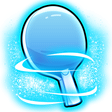Serving centre line fault
Rules
Dave Read Unknown Asked 18 years ago
Having served and there is a dispute as to whether the ball was in or out as regards the centre line, who has the decision?
An umpire at the side can hardly judge the centre line.
 Jeff Plumb Answered 18 years ago
Jeff Plumb Answered 18 years ago
Hi Dave,
The umpire has the call even though he is on the side of the table. The umpire often stands up or sits up higher for doubles so that he can see the middle line better.
The "official rules" do not allow for a point to be replayed if there is a dispute over whether the ball was in or out.
The middle line only applies to doubles, as in singles you can serve from anywhere to anywhere. However in doubles, you must serve from your right hand square, to your opponents right hand square.
If your opponents serve the ball and and you catch it because you think it is a fault and then your opponents dispute your call, it is the umpire who decides who to award the point to. If the umpire calls it a fault, you win the point, otherwise you lose the point. That is why it may be safer not to catch the ball but to play out the point and let the umpire make the decisions.
Of course, if it is a more friendly game, then the "official rules" could be bent and both sides could agree to replay the point.
Recommended Video
Serving Back into the Net
Whose point is it if I serve the ball with backspin so it bounces back into the net? We explain the rule in this video.
Watch NowThoughts on this question
Become a free member to post a comment about this question.
John Samuel Posted 10 years ago
Hi pingskills,
What if the ball touches one of the poles of the net (I stress on this, not the net but the side poles of the net) and falls back on the opposite side of the table? Is it legal or the receiver is rewarded with a point straightaway?
What if it happens while serving? Is it a re serve or a point is rewarded to the receiver?
Hi John,
The net posts are considered to be part of the net so if the ball touches the post and then goes in during a rally it is still in play. And if it touches the post and then goes onto the table during a serve it is a let.
John Samuel Posted 10 years ago
Thank you sir, very valuable information. You always inspire me